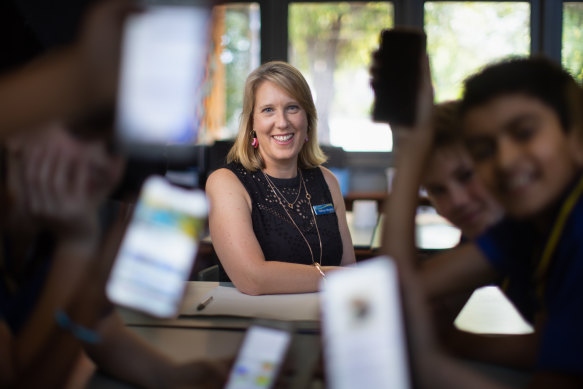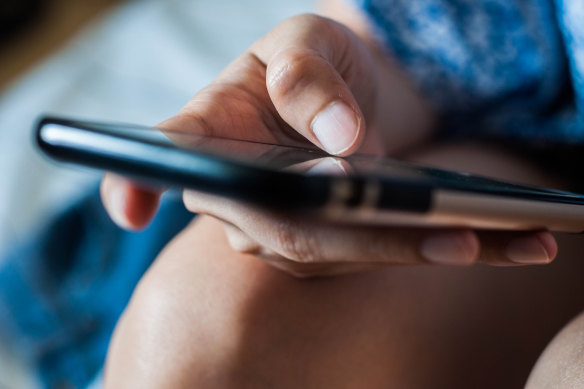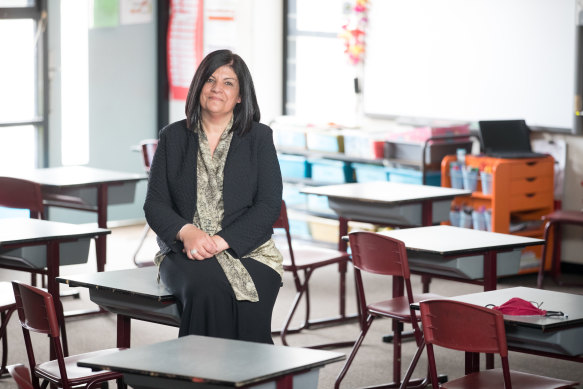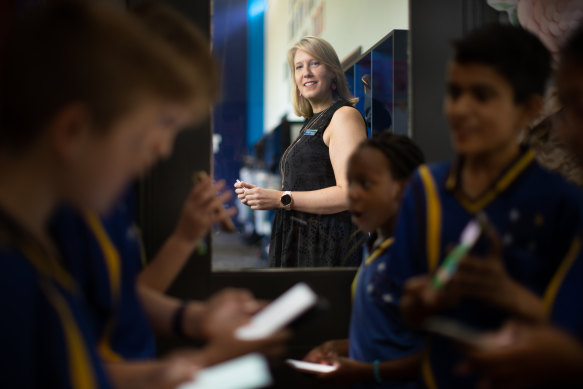Smartwatches, phones make their presence felt in primary schools
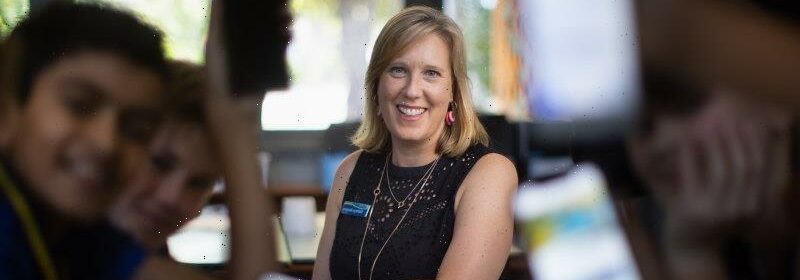
At St Luke’s primary school in Wantirna, a handful of children drop their mobile phones in a bucket each morning and retrieve them at the end of the day.
Principal Kathryn Murphy said by year’s end, the buckets would be filled with mobiles owned by every year 6 student and probably some grade 5s.
Kathryn Murphy, principal of St Luke’s primary school in Wantirna. Students drop off and collect their mobiles every day.Credit:Simon Schluter
“It used to be that a lot of grade 6s would get a mobile phone when they finished grade 6 to start year 7, but now it’s more becoming on your birthday when you’re in grade 6,” Murphy said.
Long the domain of secondary schools, mobile phones and smartwatches are becoming increasingly common in primary schools, as students push for independence and parents seek to keep track of their children.
It’s standard for students in years 5 or 6 to have a mobile, said Andrew Dalgleish, president of the Victorian Principals Association. Smartwatches have been rising in popularity since last year, said Michael Gray, president of the Victorian Association of Catholic Primary School Principals.
Over the past five years, the average age a child received their first mobile phone was between eight and 12, according to an Australian Communications and Media Authority report. But the real number of children and teens with phones is unclear, as Optus and Telstra keep details on account holders only, who are typically parents or carers.
The number of children and teens with mobiles is unclear as Telstra and Optus do not request this information. Credit:Getty Images
“The use of such devices equates to pen and paper used by previous generations,” said Australian Principals Federation president Tina King. “[The] problem we have, however, is the exponential growth in social issues which are played out online.”
Since 2020, all government primary and secondary schools have required students to turn off and store their phone during the school day, to boost social interactions and physical activity during breaks, and reduce distractions or inappropriate use such as bullying.
Non-government schools do not have blanket bans, although most require students to hand them in or lock them away. Melbourne Catholic schools have “acceptable use of information and communications technology” policies, and schools decide how to implement them, including through student and parent agreements.
At St Luke’s, students and parents must sign an agreement that phones are kept in the office during the day. Spacetalk watches, the popular mobile phone alternative for younger kids, might be added to the agreement.
Tina King says schools and parents should support students in the safe and responsible use of technology.Credit:Jason South
Murphy estimated between 20 and 30 per cent of junior students, as young as year 2, had a Spacewalk watch. These devices have a GPS tracker, allow children to contact people approved by parents and take photos and videos. They also allow parents to switch the device to “school mode” during school hours, so the internet is disabled.
Melbourne mother Janine Kearsley said she felt comfortable with her daughter walking to and from school with her phone. “It allows a bit of independence for her, and if we go to the shops, I allow her to go wander for 20 minutes, half an hour and then we’re able to ring each other and meet up again.
“She’s going into high school, so there’s more she has to learn how to do.”
Murphy said the smartwatches had benefits. “I think children should be given more responsibility, so if it means that the parent can feel confident that their children might be able to walk home from school when they’re in grade 4 or 5, they’ve actually got a way to connect with them,” she said.
But Murphy doesn’t want students taking photos on devices during school. “It should be a safe zone for everybody to not feel that they could have their photo taken at any moment during the school day,” she said.
Catherine Page Jeffery, lecturer in media and communications at the University of Sydney, said her research had found schools, parents and teachers were still finding their way in managing students’ digital technology use.
“Many parents are providing their children with phones or smartwatches such as the Spacetalk so that they can stay in touch with their children. This can afford primary-aged children a bit more freedom, for example walking to school on their own or catching the bus,” she said.
But Page Jeffery said some smart devices could be a distraction during school, and cause problems for teachers in terms of keeping students on task.
“Many of these smart devices have all sorts of features and affordances which can create problems among peers beyond being a distraction. They might be able to record videos, photos or audio of peers without consent or knowledge.”
Michael Nagel, associate professor of education at the University of the Sunshine Coast, said smartphones and smartwatches weren’t appropriate for children under 13, as research showed excessive use affected neurological development.
Nagel said “dumbphones” – which have GPS, texts and calls only – might be a healthy alternative for primary school-aged children.
“When they get to 13 or 14, they have a greater understanding or some of the issues and challenges associated with screen use,” he said.
At St Luke’s, students and parents must sign an agreement that phones are kept in the office during the day.Credit:Simon Schluter
But Jason Zagami, senior lecturer at Griffith University’s school of education and professional studies, said research had found the earlier children were exposed to technology, the more likely they were to use it appropriately.
“One of the risks of blanket bans is that it prevents or discourages schools and teachers from exploring the positive uses of these technologies where eventually we will be using them in schools,” he said.
“The issues will die away, and they’ll become an accepted part of our lives in schools, just as they are accepted in every other aspect of society.”
The Morning Edition newsletter is our guide to the day’s most important and interesting stories, analysis and insights. Sign up here.
Most Viewed in National
From our partners
Source: Read Full Article
